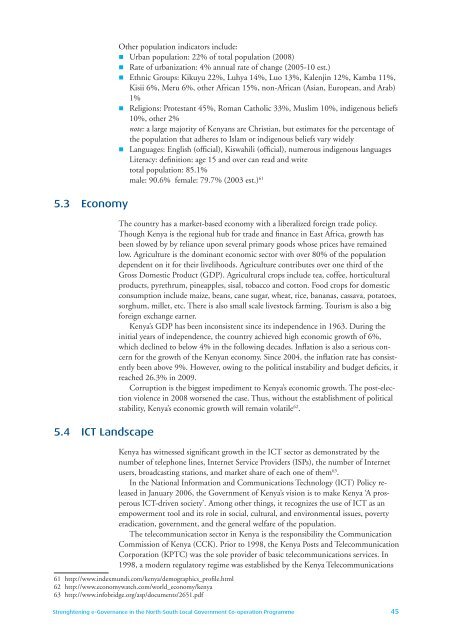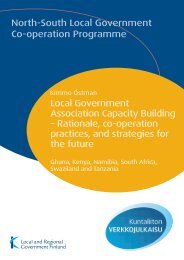E-READINESS QUESTIONNAIRE FOR NORTH ... - Kunnat.net
E-READINESS QUESTIONNAIRE FOR NORTH ... - Kunnat.net
E-READINESS QUESTIONNAIRE FOR NORTH ... - Kunnat.net
Create successful ePaper yourself
Turn your PDF publications into a flip-book with our unique Google optimized e-Paper software.
5.3 Economy<br />
5.4 ICT Landscape<br />
Other population indicators include:<br />
� Urban population: 22% of total population (2008)<br />
� Rate of urbanization: 4% annual rate of change (2005-10 est.)<br />
� Ethnic Groups: Kikuyu 22%, Luhya 14%, Luo 13%, Kalenjin 12%, Kamba 11%,<br />
Kisii 6%, Meru 6%, other African 15%, non-African (Asian, European, and Arab)<br />
1%<br />
� Religions: Protestant 45%, Roman Catholic 33%, Muslim 10%, indigenous beliefs<br />
10%, other 2%<br />
note: a large majority of Kenyans are Christian, but estimates for the percentage of<br />
the population that adheres to Islam or indigenous beliefs vary widely<br />
� Languages: English (offi cial), Kiswahili (offi cial), numerous indigenous languages<br />
Literacy: defi nition: age 15 and over can read and write<br />
total population: 85.1%<br />
male: 90.6% female: 79.7% (2003 est.) 61<br />
The country has a market-based economy with a liberalized foreign trade policy.<br />
Though Kenya is the regional hub for trade and fi nance in East Africa, growth has<br />
been slowed by by reliance upon several primary goods whose prices have remained<br />
low. Agriculture is the dominant economic sector with over 80% of the population<br />
dependent on it for their livelihoods. Agriculture contributes over one third of the<br />
Gross Domestic Product (GDP). Agricultural crops include tea, coffee, horticultural<br />
products, pyrethrum, pineapples, sisal, tobacco and cotton. Food crops for domestic<br />
consumption include maize, beans, cane sugar, wheat, rice, bananas, cassava, potatoes,<br />
sorghum, millet, etc. There is also small scale livestock farming. Tourism is also a big<br />
foreign exchange earner.<br />
Kenya’s GDP has been inconsistent since its independence in 1963. During the<br />
initial years of independence, the country achieved high economic growth of 6%,<br />
which declined to below 4% in the following decades. Infl ation is also a serious concern<br />
for the growth of the Kenyan economy. Since 2004, the infl ation rate has consistently<br />
been above 9%. However, owing to the political instability and budget defi cits, it<br />
reached 26.3% in 2009.<br />
Corruption is the biggest impediment to Kenya’s economic growth. The post-election<br />
violence in 2008 worsened the case. Thus, without the establishment of political<br />
stability, Kenya’s economic growth will remain volatile 62 .<br />
Kenya has witnessed signifi cant growth in the ICT sector as demonstrated by the<br />
number of telephone lines, Inter<strong>net</strong> Service Providers (ISPs), the number of Inter<strong>net</strong><br />
users, broadcasting stations, and market share of each one of them 63 .<br />
In the National Information and Communications Technology (ICT) Policy released<br />
in January 2006, the Government of Kenya’s vision is to make Kenya ‘A prosperous<br />
ICT-driven society’. Among other things, it recognizes the use of ICT as an<br />
empowerment tool and its role in social, cultural, and environmental issues, poverty<br />
eradication, government, and the general welfare of the population.<br />
The telecommunication sector in Kenya is the responsibility the Communication<br />
Commission of Kenya (CCK). Prior to 1998, the Kenya Posts and Telecommunication<br />
Corporation (KPTC) was the sole provider of basic telecommunications services. In<br />
1998, a modern regulatory regime was established by the Kenya Telecommunications<br />
61 http://www.indexmundi.com/kenya/demographics_profi le.html<br />
62 http://www.economywatch.com/world_economy/kenya<br />
63 http://www.infobridge.org/asp/documents/2651.pdf<br />
Strenghtening e-Governance in the North-South Local Government Co-operation Programme 45




